Heinkel He 70 F-2
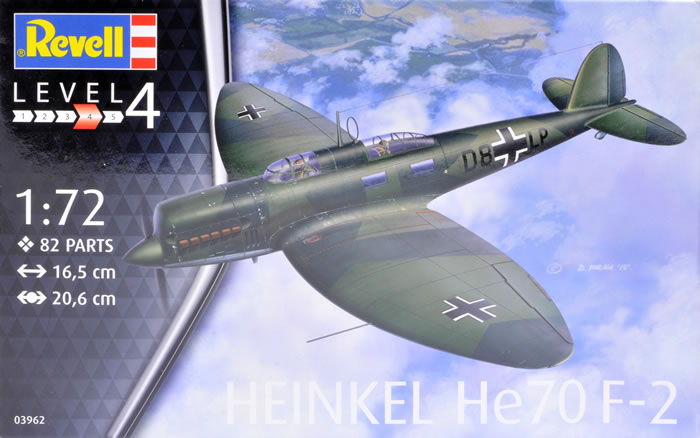
Revell, 1/72 scale
S u m m a r y : |
Catalogue Number: |
Revell Kit No. 03962 – Heinkel He 70 F-2 |
Scale: |
1/72 |
Contents & Media |
63 grey and 12 clear styrene parts, plus decals for one subject. |
Price: |
Available on-line from:
Hannants for £4.99
Squadron for US$10.95
and stockists worldwide.
Click here for currency conversion. |
Review Type: |
First Look. |
Advantages: |
The best 1/72 He 70F, exquisite surface detail, superior molding quality to early ICM boxings, great value for money. |
Disadvantages: |
None of any consequence if treated like a limited run kit. |
Conclusions: |
This Revell re-box of ICM’s He 70 appears to be an improvement in molding quality; at least as far as initial ICM releases are concerned. Other less significant advantages are the inclusion of instrument face decals and a DF loop (although this and improved quality may now apply to ICM boxings too).
The kit is features ICM’s usual exquisitely authentic surface detail; leaving modellers with the challenge of not damaging it during construction. Other detail is also very refined and realistic, although I am left with some questions regarding the accuracy of crew seating and rear cockpit layout. But to be fair, this hardly matters behind a closed canopy.
ICM’s He 70 has long been the best 1/72-scale kit of this subject, albeit not as widely available as some would like. Revell’s distribution network should remedy this concern, and at a cheaper price than ICM’s boxing in many markets.
I highly recommend this kit. |
Reviewed by
Mark Davies

Revell's 1/72 He 70 F-2 is available online from Squadron.com for only $10.95!
The Heinkel He 70 Blitz (lightning) was designed in the early 1930s to serve as a mail plane for Deutsche Lufthansa in response to a request for an aircraft faster than the Lockheed Vega and Orion used by Swissair for on short routes.
It was a low-wing monoplane, with the main characteristic of its design being its elliptical wing and its small, rounded control surfaces. In order to meet the demanding speed requirements, the design minimised drag with smooth plywood flying surfaces, flush rivets in metal areas, and a retractable undercarriage. It was powered by a liquid cooled BMW VI V12, cooled by ethylene glycol rather than water, allowing a smaller radiator to be used, and therefore reduce drag. The pilot and radio operator were seated in tandem, with a cabin housing four passengers on two double seats facing each other.
The first prototype flew on 1 December 1932, and proved to have excellent performance, setting eight world records for speed over distance, and reaching a maximum speed of 377 km/h (222 mph).
Lufthansa operated He 70s between 1934 and 1937 for a fast flight service which connected Berlin with Frankfurt, Hamburg and Cologne. He 70s were flown abroad from Stuttgart to Seville between 1934 and 1936. The route was part of the South America mail service provided by Lufthansa that continued using Junkers Ju 52/3m and Dornier Wal flying boats. Remaining aircraft were transferred to the Luftwaffe in 1937.
Twenty-eight aircraft were sent with the Legion Condor, where they were used during the Spanish Civil War as fast reconnaissance aircraft. The Luftwaffe operated He 70s from 1935, initially as a light bomber and reconnaissance aircraft. As soon as purpose build designs became available, it was relegated as a liaison and courier aircraft.
The He 70K was a Hungarian license-built reconnaissance variant powered by a WM-K-14 radial engine, and later named He 170. It was used between 1941-42, then retired from operational service due to its propensity to catch fire when atcaked, poor defensive armament, short range, and poor view from the cockpit. It was and replaced in Hungarian service by the obsolete He 46, until Bf 109 and Fw 189 aircraft were available to take over the reconnaissance role.
Source: Wikipedia.
Previous 1/72-scale He 70 Kits
By far the best known He 70/170 kit is the venerable Matchbox offering from 1988. Revell acquired the Matchbox molds in 1991; they re-boxed the kit in new style Matchbox-branded packaging for a 10-year period whilst they held a licence to use the Matchbox name. Revell chose not to renew their use of the Matchbox brand, but continued to release the He 70 and other Matchbox kits in Revell-branded boxes. An adequate and somewhat clunky kit at best, it was for many the only readily available option for a He 70 in ‘The One True Scale’.
There are three less well known He 70 kits I am aware of - Air Team models and Classic plane both released resin kits around 16-18 years ago, and the MPM-group produced a limited-run injected kit in 1987 for German brand WK models. I know nothing more than this about all three.
ICM came to the rescue with a stunningly well detailed and accurate kit in 2008, and it Revell’s recent re-boxing of this kit that is the subject of this first look.
Revell’s re-box is a close-fitting end-opening box, unlike ICM’s quite large top-opening one, as the original two main sprues are cut half; leaving four sprues to fit Revell’s box. They come packed in a single re-sealable cellophane bag, with the clear sprue further enclosed in a small bag of its own. The decal sheet and its talc are enclosed within the folded instructional booklet.
The instructions are a pleasing improvement in style over the cheap and hard to follow rubbish Revell has been providing with its kits for years. Well done Revell, it’s about time! By no means stellar examples of the instructional art; they are at least easy on the eye, and printed in colour on reasonable quality paper. They include a parts map and have clear enough assembly diagrams with colour call-outs linked to Revell’s own paint range. The colours and markings diagram is A-5 page four-view printed in colour, and a huge advance over Revell’s old cluttered monochrome drawings. (Not that I want to give the impression I haven’t liked Revell’s instructions for the past 20 years or so...)
The Kit
In general the kit’s moulding is crisp and clean with just a tiny hint of flash in places, and narrow enough sprue gates. The clear parts are excellent quality.
I did notice a slight mark on the starboard upper wing suggesting slight tool damage or abrasion in transit; so I compared Revell’s kit to my original ICM boxing bought seven years ago. It too has identical marks, suggesting tool damage. It is so slight that a very light buff & polish will remedy it.
I also compared the parts from the two boxings for sink marks in thick moldings like the flaps, as sink marks in these areas had been a recurring theme in the original reviews of the ICM kit. Interestingly, whilst this flaw was present in my ICM boxing it was completely absent from Revell’s (sink marks in ICM’s sprues were also absent from Revell’s. I don’t know if ICM supplied Revell with the molded parts, or supplied the tooling for Revell to use; but I assume for these more recent kits the tool has had its cooling improved, or cycled at a slower rate to permit more even cooling or better cavity filling, or fed at a higher pressure than previously. I can only say it seems the Revell boxing is better molded than the original ICM kits, although hopefully this improvement applies to more recent ICM production too.
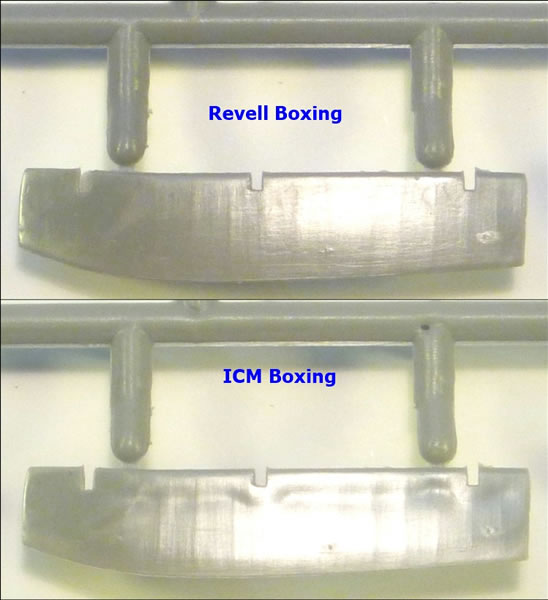
I think that ICM kits are unsurpassed when it comes to realistic and true to scale surface detail in 1/72 scale. In fact, being so true to scale is almost a curse, because some of the detail will be lost to all but the lightest of paint coats, and definitely from any sanding.
Just to digress for a moment; once you’ve laid eyes on ICM’s Ki 27, I-153, or TB-2, for example, you will never regard a Tami-edu-gawa 1/72 kit as being in the same ball-park for surface realism. If you are interested, here is link that illustrates the He 70 kit master being produced. Close examination of the kit parts shows that an epoxy, or more likely a metal-coated epoxy tool (to prolong its life), has been used to capture the master’s exquisite detail.
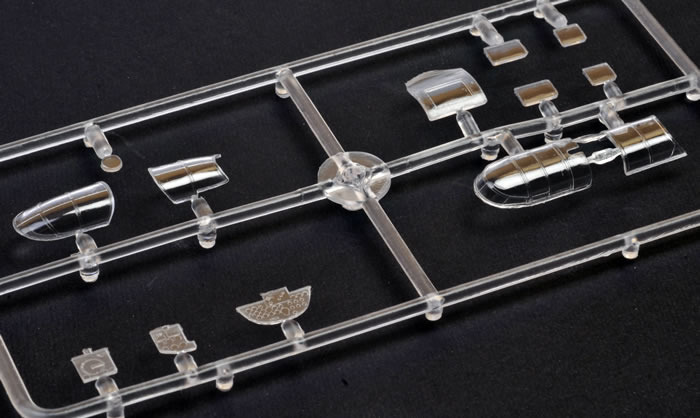
Cockpit detail is sufficient for what will be visible, and very finely moulded. The crew’s bucket-seats are very nicely done, with the thinnest sides I can recall seeing in a non-resin seat; although adding a harness will make them look even better. The pilot’s instrument panel is moulded on the clear sprue, with instrument faces provided as a decal, as is the case with the radio-operator’s two clear panels (ICM overlooked supplying decal instruments). There is also a control column, rudder pedals, throttle control, a fairly intricately shaped floor panel, front bulkhead ahead of the instrument panel, and a rear bulkhead integrated with one of the two wing spars.
If some cutaway drawings I have seen are to be believed (definitely a case of “if”), then at least some variants of the real plane had a seat for the navigator accessed via the pilot’s door behind the pilot’s seat. This space is essentially empty in the kit, although there is sort of box to fit to the floor, whilst the sidewalls and bulkhead have integrally molded structural detail. The pilot’s rear bulkhead has detail moulded in relief that includes an off-centre recessed area that looks like a crawl-way to the rear cockpit on the real plane, but is perhaps molded solid for tooling reasons.
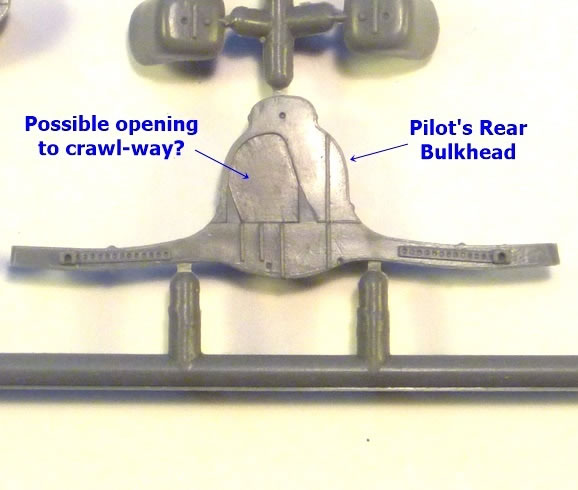
It seems from reading this linked article that there was indeed a crawlway that was normally curtained off (third paragraph down). I could not help but notice in the same article a photo of the cockpit taken from the navigator’s seat. It shows the pilot’s seat offset to the left, as represented by the kit, but it also suggests the pilot’s head protruded through an offset opening in the fuselage decking, rather than a larger opening encompassed by the bottom edge of the canopy framing in the photo below to the left. The kit does not have this feature, nor is it apparent in this photo below on the right. I have no explanation for this apparent difference between the images.

To model the military variants it is necessary to cut away some of the fuselage decking above the rear compartment. This because the kit seems optimised for the airliner variant, for which surplus airliner seating, a streamlined fairing for behind the pilot’s cockpit, tailskid, and a passenger cabin door are included. The portion to be removed for the He 70F-2 is clearly indicated on the inside of the two fuselage halves by a recessed area within the cabin roof.
The rear crew area consists of a floor, rear bulkhead, seat, and radio details. There is no internal structure molded into the fuselage sides, unlike in the front cockpit. This would be correct for the lined passenger compartment as the image below indicates, but I should think this would be stripped out on the military versions. However, given the limited number produced, it is just possible that the lining was retained for military-spec aircraft rather than change production practice.
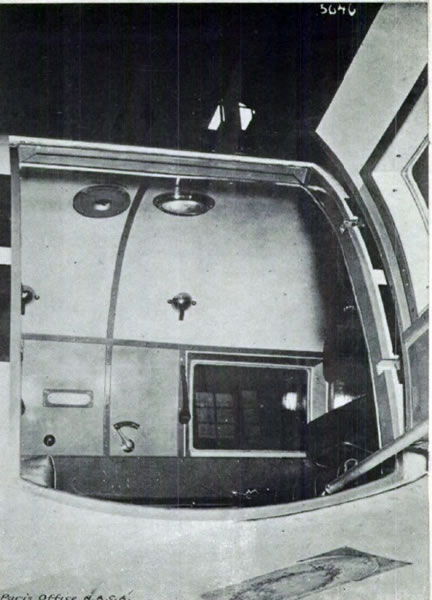
The presence of structural framing is unclear in the picture immediately below of a military-spec rear cockpit, although it may be useful for detailing.
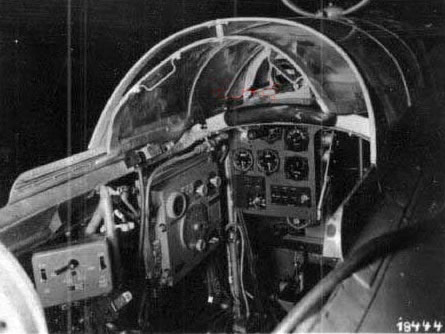
I have also included an image of the passenger cabin and pilot’s access doors open on the airliner variant simply because it is an interesting photo, and may aid modellers who choose to have their doors open.
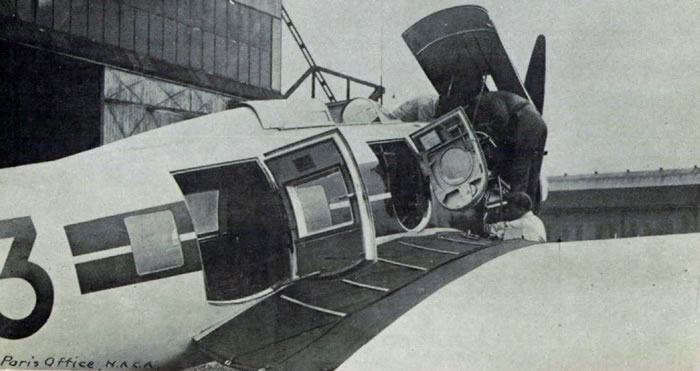
I cannot but think that the rear cockpit detail is slightly compromised, as the He 70F carried a jettisonable long-range fuel tank and camera in place of the He 70E’s bomb-cells, but these items are absent; as are any camera windows or doors in the ventral fuselage section, which presumably would be found there. Also, I am slightly puzzled at the style of the rear seat, as I would expect a less bulky foldaway item to compliment the rear gun installation. Which brings me to the kit’s MG15, magazine and gun-mount; these are blanked out on the parts map and not referred to in the kit instructions, yet most of my references show the He 70F-2 to have been equipped with a defensive machinegun.
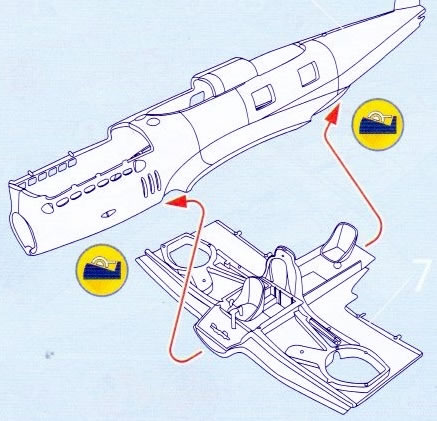
Finally, on the subject of crew, as a far as I am aware the He70F had a pilot, navigator and rear-gunner/radio-operator; yet the kit only has two seats. I think the kit’s second bucket seat is better suited for the navigator’s use located behind the pilot, and a more modest seat should be made for the gunner.
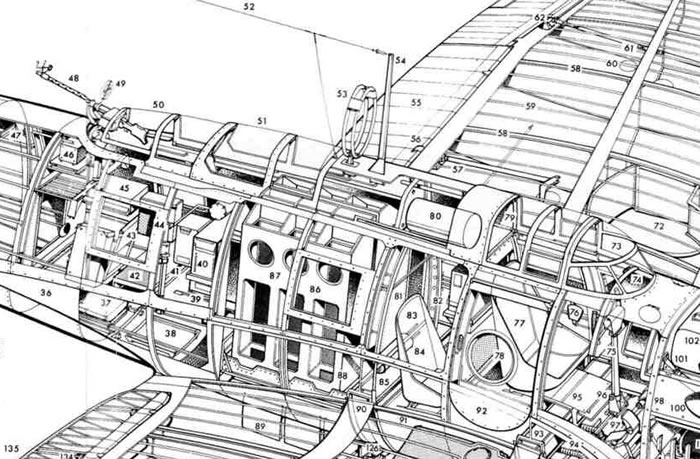
Enough speculation on cockpit details! I realize I have spent too much time on what is a very small area that will be barely visible through the multi-framed canopy. But maybe some readers will also obsess about such things. I just cannot find enough firm information on the different variants to answer the questions this first look has raised for me. Perhaps others will share what they know in the Plane Talking forum.
To finish the fuselage the various side-windows and very nicely moulded exhaust stacks must be inserted, the cowl-hood fitted, along with an acceptably fine prop and spinner. There is also radiator housing with separate matrix to fit underneath (unlike early ICM releases, there is no sink-mark in Revell’s matrix), a separate tail cone, plus a partial bulkhead to fit to the rear of the hump running between the two canopies. The challenge will be to keep the ultra-delicate metal skin detail when finishing the fuselage.
The nicely molded canopies consists a single-piece pilot’s section, and two-part rear canopy with two styles for the rearmost section; although the choice to use the one with a cut-out to clear the MG15 is not an option the instructions offer.
The He 70’s wooden wing structure was made of Spruce and skinned with plywood. The kit parts have a most amazingly delicate finish that barely hints of stress in the plywood skin where it attaches to the wing ribs. I have read a few reviews of ICM’s He 70 where the kit is described as featuring delicate fabric detail, or build articles where the Matchbox kit has been scribed as if metal-skinned. The kit’s smooth finish is undoubtedly correct, and applies to the tailplanes, tailfin and separate flaps, whilst the fixed elevators, separate rudder and ailerons have a very delicate fabric effect represented. The outboard wing halves feature a small spar extension (part # A7) that will be unseen, and may simply severe as a structural spacer for the wing halves.
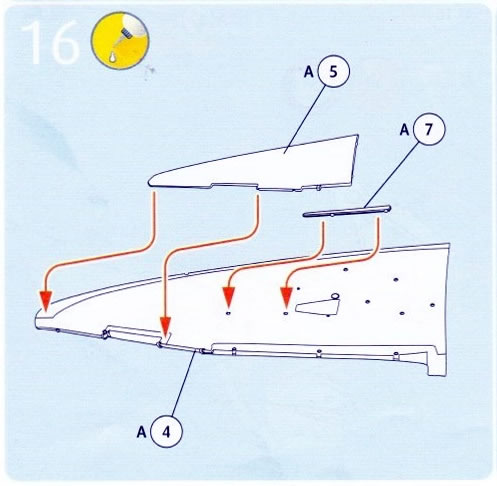
The wheel wells are lined with inserts and one of the wing spars. The main undercarriage is very well detailed, capturing the appearance of the original most effectively. The undercarriage doors are very delicate, with the circular wheel doors featuring convincing reinforcement gussets. The wheel doors need to be scored or cut to incorporate their 90o fold when lowered. The main wheels and tyres are also very convincing, as are the hubs with their brake detail. The quite small tail wheel features a spat and leg gaiter (a tail-skid is also supplied, but is a surplus part in the He 70F’s case).
All that remains to mention is the antenna mast and DF-loop. Interestingly, the DF-loop, two parts # 34 in the Revell boxing, does not appear in the ICM boxing, either in the instructions or molded on the sprues. The Revell sprues have two flat-section rings with three tiny spacers molded on one edge, perhaps so they can be joined to represent the double element used on the real DF-loop (although this would look over-scale). Revell’s instructions only show one of the two parts being used. Regardless, it tends to suggest ICM or Revell has revised the tooling at some point.
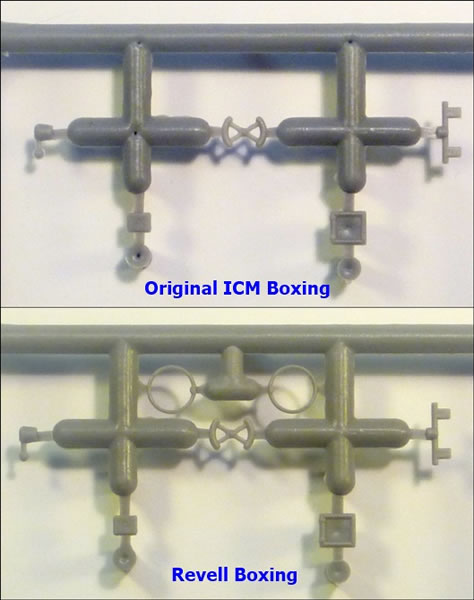
The breakdown of this kit is somewhat complex in order to achieve a high degree of realism. This aspect, and its hand-made mastering may augur for a less than perfect fit in places; and I have read some build reviews mentioning some problems. I am inclined to think that if a limited run kit approach to construction is adopted, where test fitting and adjustment is part of the expected build process, that all should go fairly well. As I mentioned before, the biggest challenge will be keeping the ultra-fine surface detail intact.
Marking Options
One scheme is provided with the kit, featuring RLM 70 & 71 splinter camouflage over RLM 65 undersurfaces. The aircraft represented is D8+LP, based at Bad Zwischenahn in 1941. This may justify the kit’s seating and absence of long-range fuel tank, as the Luftwaffe would surely have ceased using the He 70 as a reconnaissance platform; it seems far more likely D8+LP was liaison aircraft.
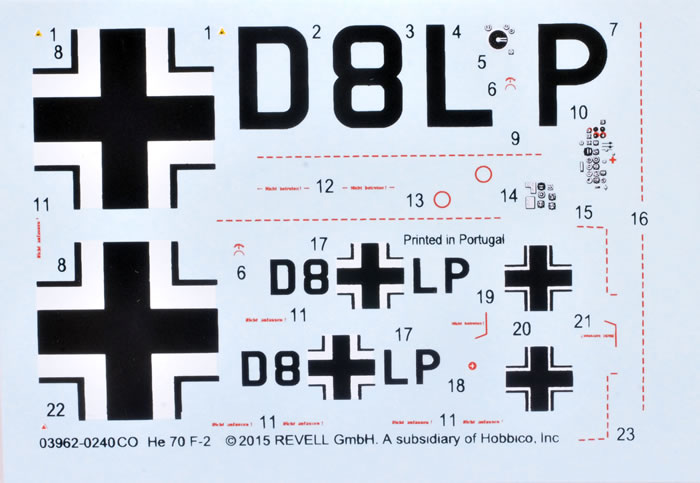
The matte-finish decals lack swastikas, but include stenciling. They appear well printed in terms of registration and colour density, but my experience of Revell decals suggests they can be very prone to silvering, so a very high-gloss base is recommended.
This Revell re-box of ICM’s He 70 appears to be an improvement in molding quality; at least as far as initial ICM releases are concerned. Other less significant advantages are the inclusion of instrument face decals and a DF loop (although this and improved quality may now apply to ICM boxings too).
The kit is features ICM’s usual exquisitely authentic surface detail; leaving modellers with the challenge of not damaging it during construction. Other detail is also very refined and realistic, although I am left with some questions regarding the accuracy of crew seating and rear cockpit layout. But to be fair, this hardly matters behind a closed canopy.
ICM’s He 70 has long been the best 1/72-scale kit of this subject, albeit not as widely available as some would like. Revell’s distribution network should remedy this concern, and at a cheaper price than ICM’s boxing in many markets.
I highly recommend this kit.
Revell model kits are available from all good toy and model retailers. For details visit www.revell.de/en, @RevellGermany or facebook.com/Revell

Review Images Copyright © 2016 by Mark Davies and Brett Green
Review Text Copyright © 2016 by Mark Davies
Page Created 19 April, 2016
Last updated
22 April, 2016
Back to HyperScale Main Page
Back to Reviews Page |
